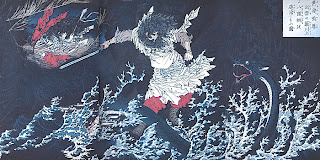Japanese mythology includes a vast number of gods, godesses and spirits. Most of the stories concern the creation of the world, foundation of the islands and the activities of deites, humans, animals, spirits and magical creatures. While some myths describe characters and events associated with particular places in Japan, other are set in legandary locations such as heavens or the underworld. Since there are a lot of stories in the mythology, I will just write about the most important and attractive two stories that I am interested in.
To start with, there was a chaotic mass, an ill defined egg, and full of seeds. Gradually, the finer parts became heaven (yang), and the heavier parts became earth (yin). Finally, the most important creator deities, the god Izanagi and the goddess Izanami appeared. They began to procreate the islands that now make up Japan as well as many of the god and goddesses.
Izanagi and Izanami
While giving birth to the fire god Kagutsuchi, Izanami was badly burned. As she lay dying, she produced more gods and goddesses. Other deities emerged from the tears of her husband. When Izanami died, she went to the land of darkness and death. Izanagi followed her and tried to get her back. As her body had already started to decay, she told her husband that she could not leave there. Izanagi could not resist looking at his beloved wife one last time.When he lit a torch and saw her rotting corpse, he fled in terror. Angry that Izanagi had seen her, Izanami sent spirits to chase him. Izanagi managed to escape, and sealed off the passage to Yomi-tsu Kuni with a huge boulder. Izanami remained there and ruled over the dead.
Feeling unclean as he contcacted with dead, Izanagi decided to bathe in a stream to purify himself. As he undressed, gods and goddesses emerged from his discarded clothes. Others came forth while he washed. Susano came from his nose, Tsukiyomi emerged from his right eye and Amaterasu appeared from his left eye. Izanagi devided the world among these three deities. He gave Susano to control oceans, assigned Tsukyomi the realm of the night and made Amaterasu the ruler of the sun and the heavens.
Probably, the best known deity in Japan mythology is the sun goddess Amaterasu whom I like most in the myth. She said to be the ancestor of the imperial family. She brings light into the world and is responsible for fertility. Her shrine at Ise is the most important shrine in Japan.
The sun goddess Amaterasu
The storm and sea god Susano
The last story that i want to talk about is between Amaterasu and her brother Susano. Susano was unhappy about his sharing the world and caused a lot of destruction. He banished to Yomi-tsu Kuni, he asked to go to the heaven to see his sister the sun goddess one last time. Amaterasu became concerned that he might be planning to take over her lands. They agreed to contest to prove their power. If Susano won, he could stay in heaven forever, but if he lost, he would have to leave. Amaterasu asked for her brother's sword which she broke into three pieces and chewed in her mouth. When she spit out the pieces, they turned into three goddess. Susano then took a string of five star shaped beads which Amaterasu gave him. He put the beads in his mouth, chewed them and spit out five gods. Susano claimed victory as he had produced five gods. However, Amaterasu pointed out that he created these gods from her possessions which proved that she was actually greater than his. Susano refused to acknowledge defeat and Amaterasu allowed him to stay in heaven.
While in heaven Susano began doing things that offended his sister and violated important taboos. He destroyed rice fields, made loud noises and dirtied the floors of her palace. Finally, Susano killed one of the horses in heaven, skinned it and hurled it into the wall where Amaterasu was weaving cloth. This so angered Amaterasu that she hid in a cave and refused to come out. When the sun goddess concealed herself, the world was plunged into darkness, plants stopped growing and all activities came to halt. Desperate for Amaterasu's return, gods gathered to discuss ways to get her back to heaven. A wise god named Omori-kane proposed a solution. The gods hung a mirror on the branches of a tree outside the cave. Then they had a young goddess named Ama no Uzume dance to music while they laughed loudly. Amaterasu heard the noice and wondered what was happening. Opening the door to cave a little, she asked why gods were so happy. They told that they were celebrating because they found a goddess superior to her. Curious at who this goddess might be, Amaterasu opened the door wider to look and saw her own image in the mirror. When she paused to look at her reflection, a god hiding nearby pulled her completely out of the cave. Another god then blocked the cave with a magic rope. After Amaterasu emerged from the cave, her ligth shone once again, and life returned to normal. To punish Susano for his actions, the gods banished him from heaven.









































